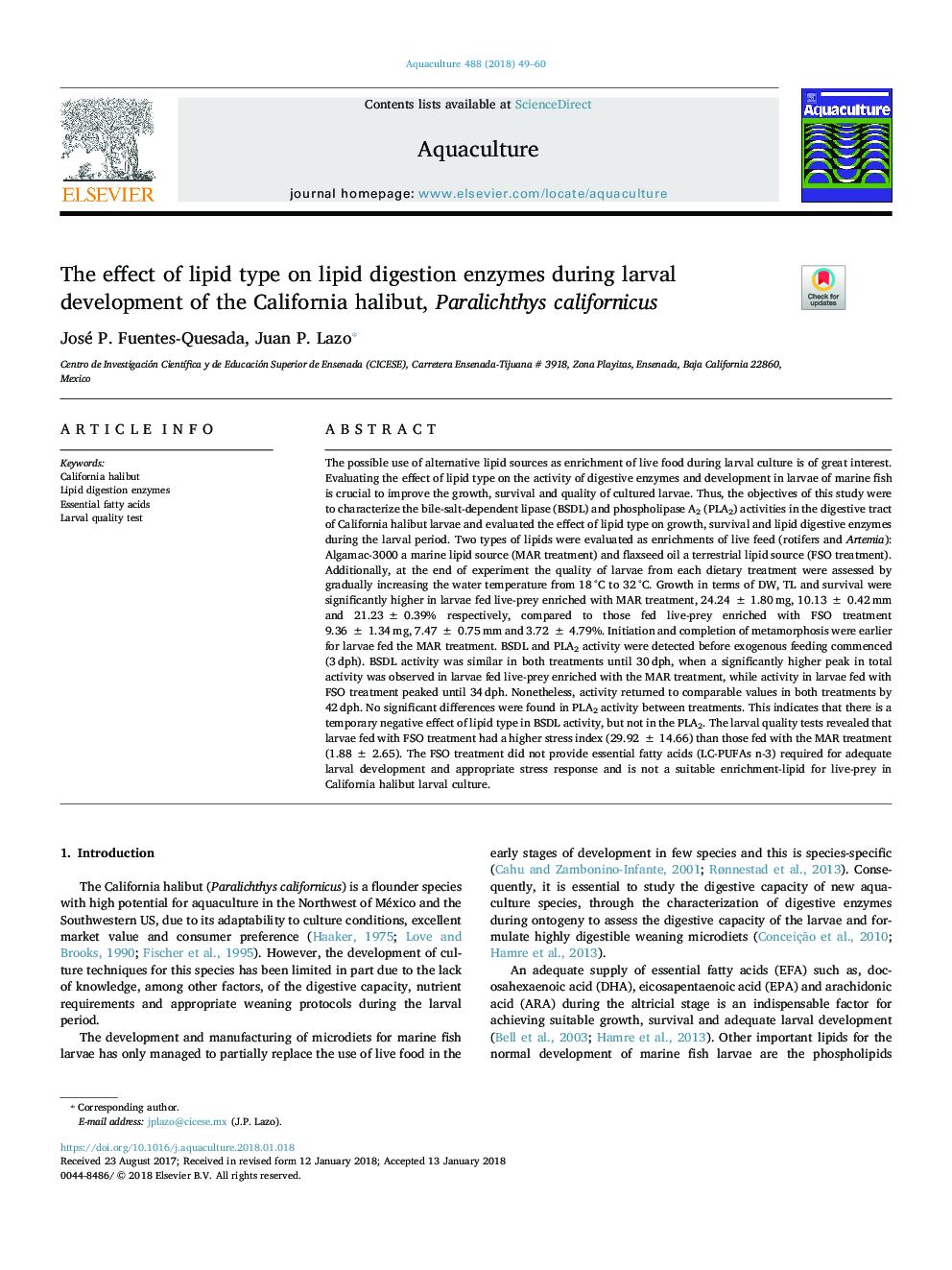| کد مقاله | کد نشریه | سال انتشار | مقاله انگلیسی | نسخه تمام متن |
|---|---|---|---|---|
| 8493385 | 1552800 | 2018 | 12 صفحه PDF | دانلود رایگان |
عنوان انگلیسی مقاله ISI
The effect of lipid type on lipid digestion enzymes during larval development of the California halibut, Paralichthys californicus
دانلود مقاله + سفارش ترجمه
دانلود مقاله ISI انگلیسی
رایگان برای ایرانیان
موضوعات مرتبط
علوم زیستی و بیوفناوری
علوم کشاورزی و بیولوژیک
علوم آبزیان
پیش نمایش صفحه اول مقاله

چکیده انگلیسی
The possible use of alternative lipid sources as enrichment of live food during larval culture is of great interest. Evaluating the effect of lipid type on the activity of digestive enzymes and development in larvae of marine fish is crucial to improve the growth, survival and quality of cultured larvae. Thus, the objectives of this study were to characterize the bile-salt-dependent lipase (BSDL) and phospholipase A2 (PLA2) activities in the digestive tract of California halibut larvae and evaluated the effect of lipid type on growth, survival and lipid digestive enzymes during the larval period. Two types of lipids were evaluated as enrichments of live feed (rotifers and Artemia): Algamac-3000 a marine lipid source (MAR treatment) and flaxseed oil a terrestrial lipid source (FSO treatment). Additionally, at the end of experiment the quality of larvae from each dietary treatment were assessed by gradually increasing the water temperature from 18â¯Â°C to 32â¯Â°C. Growth in terms of DW, TL and survival were significantly higher in larvae fed live-prey enriched with MAR treatment, 24.24â¯Â±â¯1.80â¯mg, 10.13â¯Â±â¯0.42â¯mm and 21.23â¯Â±â¯0.39% respectively, compared to those fed live-prey enriched with FSO treatment 9.36â¯Â±â¯1.34â¯mg, 7.47â¯Â±â¯0.75â¯mm and 3.72â¯Â±â¯4.79%. Initiation and completion of metamorphosis were earlier for larvae fed the MAR treatment. BSDL and PLA2 activity were detected before exogenous feeding commenced (3â¯dph). BSDL activity was similar in both treatments until 30â¯dph, when a significantly higher peak in total activity was observed in larvae fed live-prey enriched with the MAR treatment, while activity in larvae fed with FSO treatment peaked until 34â¯dph. Nonetheless, activity returned to comparable values in both treatments by 42â¯dph. No significant differences were found in PLA2 activity between treatments. This indicates that there is a temporary negative effect of lipid type in BSDL activity, but not in the PLA2. The larval quality tests revealed that larvae fed with FSO treatment had a higher stress index (29.92â¯Â±â¯14.66) than those fed with the MAR treatment (1.88â¯Â±â¯2.65). The FSO treatment did not provide essential fatty acids (LC-PUFAs n-3) required for adequate larval development and appropriate stress response and is not a suitable enrichment-lipid for live-prey in California halibut larval culture.
ناشر
Database: Elsevier - ScienceDirect (ساینس دایرکت)
Journal: Aquaculture - Volume 488, 10 March 2018, Pages 49-60
Journal: Aquaculture - Volume 488, 10 March 2018, Pages 49-60
نویسندگان
José P. Fuentes-Quesada, Juan P. Lazo,